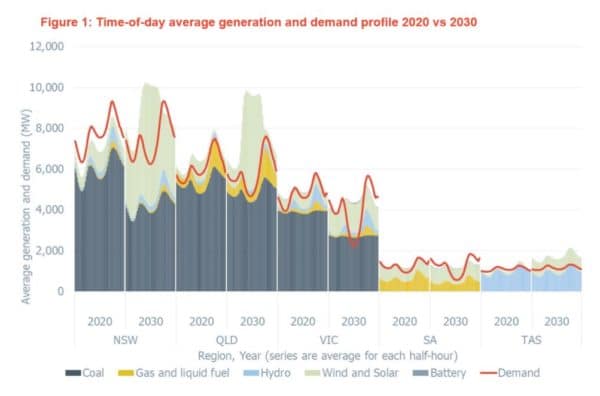New research from Cornwall Insights Australia predicts that by 2030, when all states and territories’ renewable targets have been delivered, there will be a staggering 12 GW excess generation, including from wind and solar, across the entire NEM in the middle of an average day.
Cornwall’s senior policy and regulatory consultant Franklin Liu said excess generation would present a challenge to the stability of the NEM, which interconnects Queensland, New South Wales, the Australian Capital Territory, South Australia, Victoria and Tasmania, and delivers about 80% of all electricity consumption in Australia.
With most state governments already committed to forcing renewables into the grid at record pace, Australia’s transition to renewables has been impressive but Liu said the lack of consultation and co-ordination could make for a problem.
The Clean Energy Regulator (CER) revealed in its December Quarter 2020 Quarterly Carbon Market Report that by the end of 2020 Australia had installed 32 GW of renewable energy capacity, including a record 7 GW in 2020 alone.
“NEM states have committed to a headlong charge towards their respective renewable targets by 2030,” Liu said.
“Although, with 12 GW of excess generation across the NEM, it is unclear if the states have consulted each other on their individual policies’ impact.
“Additional interconnectors are of no help if all regions are trying to export. So, it begs the question, what can be done to manage this excess supply at midday?”

Liu said while excess supply can be transported across time by storage, he warned the predicted oversupply dwarves the 2 GW Snowy 2.0 and a few GWs of other storage planned by the government and the industry.
“They could also push out coal and gas,” he said, adding it is now widely agreed that the exit of thermal plants will be faster than initially expected, as evidenced by Yallourn’s recent closure announcement.
“This could cause some challenges for grid security during the transition, and the Energy Security Board is looking for a solution in its post-2025 market design package.”
Liu said to better facilitate a smooth transition to renewable energy, states could try planning things better by taking “a more holistic, NEM-wide view together”.
“Rather than focusing on generating more green energy within their borders, states could better utilise their respective advantages and trade with each other,” he said.
“For example, states with better pumped hydro resources could build more of this technology, which could help manage their own and their neighbours’ excess energy. This, in turn, might support more renewable generation across the whole NEM, maybe even without increasing the total cost.
“Interestingly, this sounds more and more like the original design objective of the NEM, which is to promote long-term consumer interests through better trade and co-ordination.”
This content is protected by copyright and may not be reused. If you want to cooperate with us and would like to reuse some of our content, please contact: editors@pv-magazine.com.









By submitting this form you agree to pv magazine using your data for the purposes of publishing your comment.
Your personal data will only be disclosed or otherwise transmitted to third parties for the purposes of spam filtering or if this is necessary for technical maintenance of the website. Any other transfer to third parties will not take place unless this is justified on the basis of applicable data protection regulations or if pv magazine is legally obliged to do so.
You may revoke this consent at any time with effect for the future, in which case your personal data will be deleted immediately. Otherwise, your data will be deleted if pv magazine has processed your request or the purpose of data storage is fulfilled.
Further information on data privacy can be found in our Data Protection Policy.